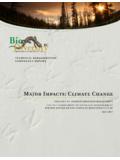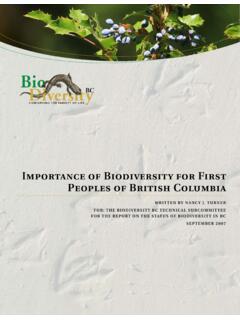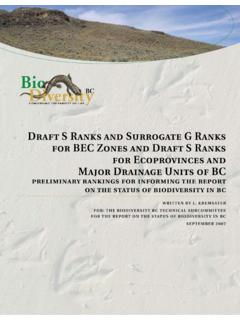Transcription of Ecological Concepts, Principles and Applications to ...
1 Ecological Concepts, Principles and Applications to Conservation2008 Ecological Concepts, Principles and Applications to Conservation2008 Library and Archives Canada Cataloguing in Publication DataMain entry under title: Ecological concepts, Principles and Applications to conservationEditor: T. Vold. Cf. 978-0-7726-6007-71. Biodiversity conservation. 2. Biodiversity. 3. Ecosystem management. I. Vold, Terje, 1949 . II. Biodiversity 2008 C2008-960113-0 Suggested citation: Vold, T. and Buffett (eds.)
2 2008. Ecological Concepts, Principles and Applications to Conservation, BC. 36 pp. Available at: photos: Jared Hobbs (western racer); Arifin Graham (footprints in sand).Banner photos: Bruce Harrison (p. 1); iStock (p. 7, 19).Design and Production: Alaris DesignTa le o ContentsAbout This Document vAcknowledgements vi1. What is Biodiversity? 12. Ecological Concepts and Principles 73. Application of Ecological Concepts and Principles 19 Glossary 32 List of Figuresf gu . Examples of Biodiversity Components and Attributes 2f gu 2.
3 The Contribution of Biodiversity to Human Well-Being 3f gu 3. Overview of Concepts, Principles and Applications 5Ac no ledge entsThe document was prepared by Biodiversity BC under the direction of its Technical Subcommittee, whose members reviewed and provided comment on various drafts. Members of the Technical Subcommittee include: Matt Austin, Ministry of Environment, Dan Buffett, Ducks Unlimited Canada, Dave Nicolson, Nature Conservancy of Canada, Geoff Scudder, The Nature Trust of British Columbia, Victoria (Tory) Stevens, Ministry of Biodiversity BC secretariat supports the work of the Steering Committee and the Technical Subcommit-tee and provides ongoing strategic advice.
4 The secretariat consists of Stuart Gale, executive director, and Janet Fontaine, document was prepared under contract by Terje Vold with project direction and contributions by Dan Buf-fett on behalf of Biodiversity BC. Three experts kindly agreed to be interviewed as part of this project and provided valuable reference material and ideas that have been incorporated into the document: Fred Bunnell, University of British Columbia, Faculty of Forestry; Ken Lertzman, Simon Fraser University, School of Resource and Environmental Management; and John Reynolds, Simon Fraser University, Department of Biological Sciences.
5 John Reynolds, Ken Lertzman, Kaaren Lewis, Doug Biffard, Andrew Harcombe, Kristy Ciruna, Dianna Colnett, Michael Dunn, Liz Williams and Bruce Harrison reviewed and commented on an initial draft; Holling and Gordon H. Orians kindly reviewed and provided feedback on a subsequent draft; and a final draft received the benefit of further review and comment by Fred Bunnell, Carmen Cadrin and John Richardson. David Greer edited the report and Arifin Graham designed it. A o t t is doc entThe purpose of this document is to provide a primer on the concepts and Principles that support cooperative ac-tions to conserve s rich biodiversity.
6 As a companion piece to Taking Nature s Pulse: The Status of Biodiversity in British Columbia, this document is intended to stimulate public discussion about how best to identify and implement priority actions for biodiversity conservation in this document was prepared by Biodiversity BC, a partnership of government and non-government organiza-tions with a mandate to produce a biodiversity strategy for British BC Partner groups: Ministry of Agriculture and Lands, Ministry of Environment, Canadian Parks and Wilderness Society (representing environmental non-government organizations), Ducks Unlimited Canada, Environment Canada, Habitat Conservation Trust Foundation, Metro Vancouver (representing the Union of British Columbia Municipalities), Nature Conservancy of Canada, Pacific Salmon Foundation, The Land Conservancy of British Columbia, and The Nature Trust of British document consists of three parts: 1.
7 What is biodiversity?: a definition of biodiversity and its value; 2. Ecological concepts and Principles : general understandings and assumptions about biodiversity; and 3. Application of Ecological concepts and Principles : ways to maintain biodiversity including what can be done and how to do it. g , 1 W at is Biodiversity? Defining BiodiversityThe Canadian Biodiversity Strategy defines biodiversity as the variety of species and ecosystems on Earth and the Ecological processes of which they are a part including ecosystem, species, and genetic diversity components.
8 The United Nations Convention on Biological Diversity provides a similar definition for biodiversity: the variability among living organisms from all sources including, inter alia [among other things], terrestrial, marine and other aquatic ecosystems and the Ecological complexes of which they are part; this includes diversity within species, between species and of ecosystems. In short, the term is used to refer to life in all its forms and the natural processes that support and connect all life forms.
9 Biodiversity is not easily defined because it is more than just the sum of its parts, as all of its elements, regardless of whether we understand their roles or know their status, are integral to maintaining functioning, evolving, resilient ecosystems. Complex concepts such as biodiversity are often easier to grasp if reduced to their component pieces. While this approach does not give a complete picture of how these pieces interact and combine to create biodiversity, it helps us understand different aspects of levels of organization of biodiversity include ecosystems, species and genes.
10 An ecosystem is a dynamic complex of plant, animal and microorganism communities and non-living (abiotic) elements, all interacting as a functional unit. An ecosystem s character changes as community 2 g , EcosystemEcosystems in an areaPatch sizeConnectivitySpeciesSpecies richness in an areaAbundancePredator/prey dynamicsGeneticNumber of unique genes in a populationRelative abundance of each unique gene in a populationAdaptationCOMPONENT/ATTRIBUTE COMPOSITION structure FUNCTION members and physical contexts change, sometimes crossing a threshold of tolerance within the system that results in its inability to return to its previous form.




